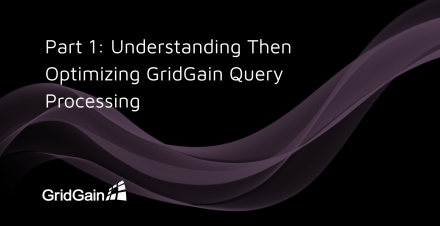The GridGain Systems In-Memory Computing Blog
Introduction
In this two-part blog post, we will first explore and understand the major steps that are executed by GridGain’s SQL query processing engine. More importantly, we will share how data is exchanged in the above process and learn about certain limitations that exist within this process.
After learning the basics in part one, we will then explore how to overcome those…
This six-minute Micro Learning Unit explores how distributed data is implemented in Apache Ignite and identifies solutions to three key data challenges: hardware capacity, hardware reliability, and performance issues.
Capacity: It’s more efficient to scale data capacity horizontally than vertically. For example, extremely fast CPUs typically cost several times as much as two slightly slower…
Today, we are thrilled to announce the release of GridGain Platform v8.9, adding new and enhanced integrations with popular data formats – including Apache Parquet, Apache Iceberg, CSV, and JSON – in order to enable more complete real-time analysis of your increasingly complex enterprise data.
These enhancements make large volumes of enterprise data in data lakes and semi-structured…
GridGain is happy to announce that we have released our latest Micro Learning Unit, a 10-minute, hands-on training course on how to execute Your First Queries With Apache Ignite.
In 10 minutes, we take you through writing your first queries using the three techniques of standard SQL, SQL via Java APIs, and Ignite’s KeyValue pair API.
This course is designed for you to follow along. Don’t…
First, there were DBMSs and data warehouses. Then came data lakes and event stream processing
platforms. Now, the most advanced data solutions are Unified Real-Time Data Platforms. But what are
they?
Unified Real-Time Data Platforms simplify and optimize data architectures by combining
transactional, stream, and analytical processing across data silos into a single “unified” platform. These…
GridGain recently published a micro-learning unit on GridGain University that delves into the different data loading strategies for Apache Ignite. These strategies include initial/regular batch load from files, database loading, real-time streaming, and ETL (Extract Transform & Load).
Here is an overview of some of the key strategies. Watch the full 9-minute video here.
Initial /…
Held on June 6, 2023, this year's Ignite Summit showcased the breadth and flexibility that make Apache Ignite a foundational technology for many demanding data use cases. Presenters represented a wide range of organizations, from financial services and telecommunications to programming language development.
Organized by GridGain and the Apache Ignite community, Ignite Summits…
In this post, we will be discussing the GridGain Nebula managed service offering for Apache Ignite, available on the GridGain portal. The main benefits of GridGain Nebula are that it simplifies cloud provisioning and provides managed service support.
What is Apache Ignite?
Before we begin, let’s take a look at Apache Ignite. At a very high level, Apache Ignite and GridGain are both in-memory…
Businesses today are increasingly complex leading to slow performance which negatively impacts customer experiences, productivity, and ultimately revenue. An in-memory data fabric addresses data complexity head-on.
Companies today are facing a significant problem – their reliance on disk-based data stores are slowing down performance and costing them valuable time and money. Enter GridGain’s…
The Apache Ignite native persistence storage engine follows a classic database approach based on the ARIES architecture. However, the Ignite developers needed to make some adjustments to the architecture in order to improve development speed and support memory-only storage.
In this blog, I will provide an overview of the Ignite native persistence storage engine and discuss the tradeoffs that…


















